Center of Gravity - How Regulation is Warping Washington’s Housing Market


Imagine Washington’s rental housing market as a solar system—each participant, from rental housing providers and tenants to investors and policymakers, moves in a delicate orbit. At the heart of this system lie fundamental economic forces: Rental Yield & Cash Flow, Housing Supply & Demand, Financing Conditions, Market Stability, Cap Rates & Value, and Vacancy & Expenses.
When these fundamental forces align, the market thrives. Investors confidently fund housing projects, developers build ample rental supply, housing providers offer stable, affordable homes, and renters benefit from abundant housing options. Much like gravity keeps planets in a steady orbit, these economic fundamentals maintain predictable market movements, fostering financial stability and affordability across the rental housing ecosystem.
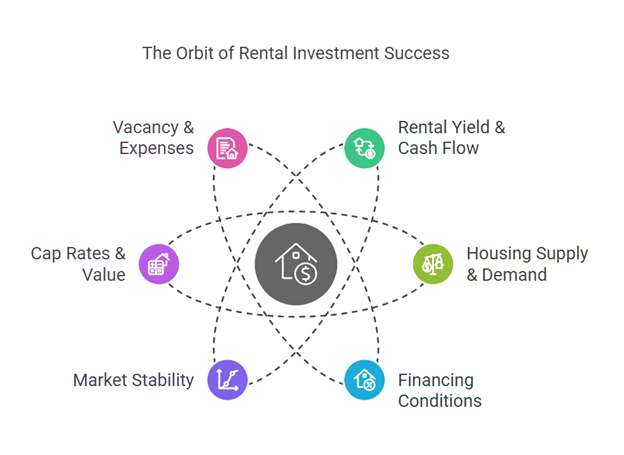
Historically, Washington’s rental housing market demonstrated a healthy balance among these core elements, providing predictable returns and sustained growth for investors and a variety of housing options for tenants. 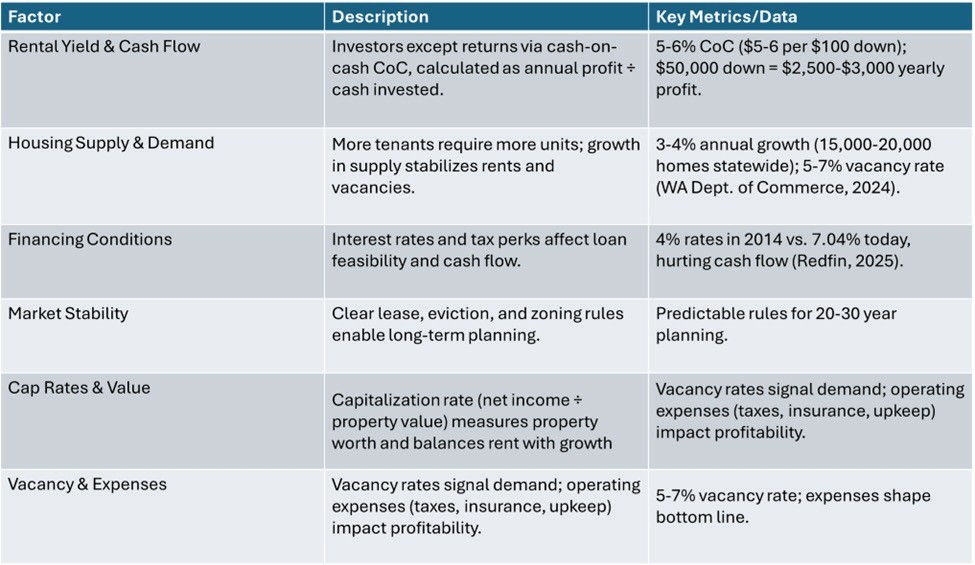
When conditions were favorable, rental housing investments performed robustly across various property types.
2014 Rental Housing Market Fundamentals: Cash Flow, Returns, and Stability
- Single-family homes provided consistent appreciation and valuable tax breaks despite negative cash flow if leveraged.
- Duplexes offered stable returns, driven by fair rents and balanced competition.
Multi-family properties (12-unit buildings) delivered strong profitability with impressive cash-on-cash returns of up to 16.5%, reflecting economies of scale and predictable zoning environments.
Carl von Clausewitz, the legendary Prussian military strategist, described the Center of Gravity (CoG) as "the hub of all power and movement," a concept essential to understanding strategic success. In Washington’s rental housing market, the CoG lies precisely in these economic fundamentals. Properly nurturing this core ensures stability and affordability. Conversely, neglecting or disrupting these foundational elements through excessive regulation, such as rent control or restrictive zoning, can have devastating outcomes—akin to a gravitational disruption that causes a solar system to spiral into chaos.
Recent trends indicate that Washington policymakers have shifted focus away from these fundamentals, mistakenly targeting symptoms rather than root causes. The resulting destabilization has caused a troubling trajectory for housing affordability, investment viability, and market stability. These interventions threaten to pull Washington’s rental housing market off its balanced orbit, risking economic and social harm.
As you will see in the following sections, Washington must quickly restore the gravitational balance—its true Center of Gravity—by reinforcing economic fundamentals and reversing the trajectory of overregulation before it becomes irreversible.

If Washington’s rental housing market is akin to a solar system operating in delicate balance, recent regulatory interventions have introduced a disruptive gravitational force—one strong enough to threaten the stability of the entire system. Policies such as rent caps, restrictive zoning laws, and increasingly complex compliance mandates have significantly warped the core economic fundamentals essential to sustained housing investment, affordability, and supply.
Financial Impacts of Regulatory Distortion
Today's financial realities vividly illustrate how deeply regulatory interventions have eroded profitability and destabilized Washington’s rental market:
- Single-Family Homes: With median values reaching $605,400 and average annual rents around $24,000, rental providers now confront annual negative cash flows exceeding $28,000. Leveraged returns have plummeted to -23.5% at current interest rates of 7.04%, turning investment in single-family homes from stable to financially unsustainable.
- Duplexes (Multi-Family Units): Even duplexes, traditionally reliable sources of moderate returns, now experience annual losses of more than $16,000 and leveraged returns of -10.3%, discouraging providers from maintaining or expanding these smaller-scale rental options.
- Larger Multi-Family Buildings: Despite economies of scale, a typical 12-unit property valued at $2.5 million, generating $216,000 annually, still faces significant shortfalls, with leveraged returns around -12%, translating to nearly $60,000 in annual losses.
These figures aren't abstract; they vividly illustrate a market under severe stress, a direct consequence of policies that have severely distorted economic fundamentals. Restrictive regulations, costly compliance measures, and unfavorable financing conditions have undermined rental housing providers’ financial stability, discouraging both ongoing investment and new construction.
Consequences for Tenants and Housing Providers
These financial impacts are not theoretical—they significantly affect real lives, communities, and housing quality:
- For Tenants:
o Reduced Safety: Regulations intended to protect tenants, such as restrictive eviction laws, inadvertently shield problematic residents, decreasing community safety and creating dangerous environments for families.
o Rising Rents: Constrained housing supply increases competition, pushing rents upward and intensifying financial pressure on renters, particularly low-income households.
o Limited Options: With vacancy rates now below 4%, new housing options diminish, resulting in longer waitlists, deteriorating unit quality, and reduced tenant mobility. - For Housing Providers:
o Mounting Financial Pressures: High mortgage rates, escalating operational costs, and regulatory complexity create overwhelming financial burdens, eroding profitability and threatening the viability of rental businesses.
o Investment Retreat and Aging Stock: Restrictive zoning and permitting delays slow new construction, forcing providers to maintain aging units at increasingly prohibitive costs.
o Regulatory Uncertainty: Constantly shifting regulations create unpredictable market conditions, deterring essential long-term investments and harming strategic planning.
Supply Crisis Driven by Regulatory Misdiagnosis
Washington welcomed more than 83,000 new residents in 2022 alone, underscoring the urgent need for new housing. Yet rather than facilitating construction, policymakers have mistakenly introduced measures, such as rent control, restrictive zoning, and compliance-heavy mandates—that severely limit supply growth.
These interventions fundamentally misunderstand the crisis. Rising rents and homelessness are symptoms—not root causes—of the housing shortage. Policymakers' fixation on symptoms, rather than addressing the true Center of Gravity (housing supply and private investment), only intensifies the problem, further destabilizing the housing ecosystem.
As Clausewitz warned, misidentifying the true CoG inevitably leads to strategic failure. Washington’s current trajectory threatens the rental housing market’s very foundations, risking prolonged instability and unaffordability unless corrective actions are urgently taken.

 Carl von Clausewitz, the influential Prussian military strategist, defined the Center of Gravity (CoG) as the decisive element—the "hub of all power and movement"—that determines success or failure in any conflict or system. Accurately identifying and protecting the CoG ensures victory, while misidentifying it guarantees defeat.
Carl von Clausewitz, the influential Prussian military strategist, defined the Center of Gravity (CoG) as the decisive element—the "hub of all power and movement"—that determines success or failure in any conflict or system. Accurately identifying and protecting the CoG ensures victory, while misidentifying it guarantees defeat.
In warfare, the CoG might be an adversary’s leadership, communication networks, or supply chains. In economics and housing, it represents the critical interplay of housing supply, demand, and private investment conditions. When this core is nurtured, housing markets thrive: providers invest, new units are built, and affordability naturally stabilizes. When neglected or misunderstood, markets spiral rapidly into dysfunction.
The Danger of Misidentifying the CoG
Clausewitz explicitly warned about the catastrophic consequences of incorrectly identifying the CoG: wasted resources, strategic confusion, and inevitable failure. Washington’s current housing policies exemplify precisely this error. Policymakers have mistakenly targeted symptoms—such as rising rents and homelessness—rather than addressing the true root cause: a severe shortage of housing supply and the constraints on private investment.
By embracing measures like rent control, restrictive zoning, and complex tenant regulations, policymakers have artificially constrained housing market forces. Instead of improving affordability, these policies deter investment, reduce construction, and exacerbate supply shortages, achieving exactly the opposite of their stated goals.
The Black Hole of Regulation: A Misidentified CoG in Action
Just as a black hole distorts and ultimately consumes everything nearby, Washington’s misidentified CoG—excessive regulation—threatens to destabilize and destroy the housing market’s natural equilibrium. The resulting negative outcomes are clear and rapidly intensifying:
- Reduced Construction: Restrictive zoning and prolonged permit processes drastically limit new housing, weakening the market’s natural responsiveness.
- Investment Retreat: Regulatory unpredictability undermines market confidence, causing investors to withdraw their resources and pursue more stable environments elsewhere.
- Economic Instability: Reduced investment and constrained supply cause dramatic rent escalation, shrinking vacancies, and accelerating market dysfunction that harms tenants, housing providers, and communities alike.
By allowing regulation to replace essential economic fundamentals like housing supply, investment, and market stability as the new gravitational core, policymakers risk deepening the housing crisis rather than resolving it.
Correcting the Course: Restoring the True CoG
Clausewitz’s fundamental lesson remains clear: victory requires accurate identification and decisive protection of the true CoG. For Washington, this means urgently shifting housing policy away from regulation-focused interventions back to nurturing housing supply growth and fostering private investment. This shift is essential to reestablish market equilibrium, achieve genuine affordability, and ensure sustainable, long-term economic stability. Continuing down the path of excessive regulation ensures only deeper instability and worsening affordability. Policymakers must realign housing strategy around the true CoG—housing supply, investment conditions, and market-driven stability—before the state crosses the threshold into irreversible decline.

Historically, Washington’s rental market thrived on a stable interplay of housing supply, demand, and private investment—its true Center of Gravity (CoG). Yet recent legislative initiatives and regulatory proposals threaten to dangerously reposition this CoG away from economic fundamentals, placing excessive regulation at the center instead. Rather than directly addressing the root problem—a critical shortage of housing—policymakers have concentrated on symptoms like rising rents and homelessness. In doing so, they mistakenly target housing providers as adversaries rather than allies, overlooking the actual barriers to housing affordability: rapidly increasing costs for financing, insurance, maintenance, taxes, and compliance requirements.
Proposed Regulations and Their Risks
Several new regulatory proposals illustrate clearly how shifting the CoG toward government intervention rather than market fundamentals risks severe negative outcomes:
- Rent Control Measures: While well-intentioned, rent control creates profound uncertainty, severely discouraging developers from building new housing. Experience elsewhere vividly demonstrates how rent caps drastically reduce supply growth rather than improving affordability.
- Expanded Tenant Protections: Increased tenant regulations introduce significant operational complexity, financial risk, and unpredictability. These policies fail to increase housing supply and instead elevate compliance costs, discouraging future investment and leading to deteriorating housing conditions.
- Government Subsidies and Mandates: Temporary subsidies and mandates may offer short-term relief but cannot resolve long-term structural supply shortages. Instead, they foster dependency cycles, increase long-term financial burdens, and fail to address the fundamental problem—a shortage of new housing units.
The Risks of Shifting the CoG to Regulation
The impacts of positioning regulation as the housing market’s Center of Gravity (CoG) are severe and demonstrable:
- Investment Pullback: Developers and rental providers face increasingly unpredictable regulatory landscapes, deterring vital investment and deepening the existing housing supply shortage.
- Supply Shortfall: Already burdened by restrictive zoning and permitting delays, further regulatory hurdles will significantly slow or halt essential new construction, magnifying Washington’s housing shortfall.
- Accelerating Affordability Crisis: With fewer units constructed, rental competition intensifies, pushing rents sharply upward. Tenants, particularly lower-income households, suffer most under these conditions, facing dwindling choices and deteriorating housing conditions.
Washington doesn’t need speculation to understand these consequences—the evidence is abundant from neighboring cities that have pursued a similar regulatory path. Portland, Oregon, provides a sobering example of the dangers inherent in overregulation:
- Portland: A Cautionary Tale of Regulatory Collapse
Since implementing restrictive housing policies, Portland has faced a dramatic reduction in housing investment, surging homelessness, escalating crime rates, and significant economic decline. - Housing supply shrank significantly due to restrictive zoning and rent control.
- Investment collapsed, leading to widespread job losses—approximately 14,600 construction jobs disappeared between 2019 and 2023.
- Homelessness surged, as the city misdirected resources into temporary solutions rather than addressing underlying supply shortages.
- Public safety and livability deteriorated dramatically, driving residents and businesses away, shrinking the tax base, and straining public services.

In astrophysics, a supermassive black hole represents an overwhelmingly destructive force, pulling everything within its reach toward an irreversible collapse. Similarly, excessive regulation in housing policy acts like such a black hole, exerting a destructive gravitational pull that can devastate housing markets, local economies, and communities.
Washington currently teeters precariously close to its own economic black hole. Instead of prioritizing strategies that encourage housing growth and investment, policymakers are increasingly adopting short-term regulatory solutions—rent control, overly restrictive tenant protections, and heavy-handed mandates—that threaten to destabilize the entire system. Far from solving underlying issues, these policies are creating distortions that drive away the investments essential to sustaining affordable housing.
Portland: A Cautionary Tale of Regulatory Collapse
Washington doesn’t have to look far for vivid proof of these dangers. Portland, Oregon, offers an alarming preview of what awaits when regulatory strategies eclipse the foundational market dynamics:
- Escalating Homelessness and Public Safety Crisis: Despite spending over $1 billion on homelessness interventions since 2019, Portland’s situation has deteriorated rapidly. The city prioritized short-term shelter solutions and restrictive policies over enabling a market-driven increase in housing supply, inadvertently deepening structural housing shortages.
o Record Homeless Deaths: At least 315 homeless individuals died in Portland in 2022 alone.
o Drug Epidemic: Over half of these fatalities involved overdoses (85% methamphetamine, 74% fentanyl), highlighting systemic failure rather than improvement (EMS1, 2024).
Oregon’s Failed Rent Control Experiment
In 2019, Oregon implemented statewide rent control (Senate Bill 608), capping annual rent increases and restricting evictions in an attempt to manage housing affordability. Rather than stabilizing rents, this policy had disastrous unintended outcomes:
- Reduced Supply: New rental construction plummeted, as investors and developers withdrew capital due to diminished returns and regulatory unpredictability.
- Accelerating Rents: With fewer new units, uncontrolled units saw sharp rent increases as competition intensified.
- Increasing Homelessness: Despite significant spending on temporary shelters, Oregon’s homeless population grew dramatically, directly tied to constrained housing availability.
The Urban Doom Loop: Economic and Social Decline
Portland is now locked into what urban planners term an "Urban Doom Loop"—a destructive cycle triggered by housing unaffordability, resulting in broad economic and social deterioration:
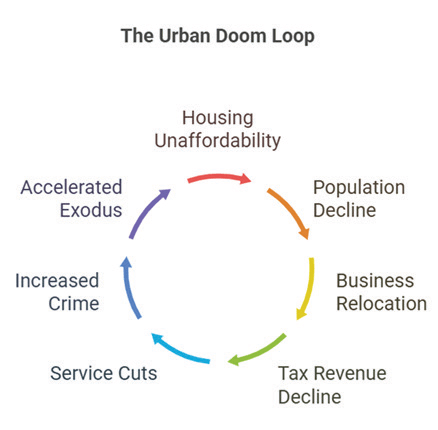
- Housing unaffordability forces residents to leave.
- Population decline weakens the consumer base for local businesses.
- Business relocation shrinks the tax base, causing revenues to fall.
- Declining tax revenues result in severe cuts to essential public services.
- Reduced public services degrade infrastructure, schools, and public safety.
- Increased crime and deterioration further drive residents away, intensifying the cycle.
Once initiated, this "Urban Doom Loop" becomes extremely difficult to reverse, rapidly deteriorating economic health and community vitality.
Why This Matters for Washington
Portland’s situation isn't a distant hypothetical—it's an immediate cautionary tale. If Washington policymakers continue their current regulatory path, they risk replicating Portland’s outcomes:
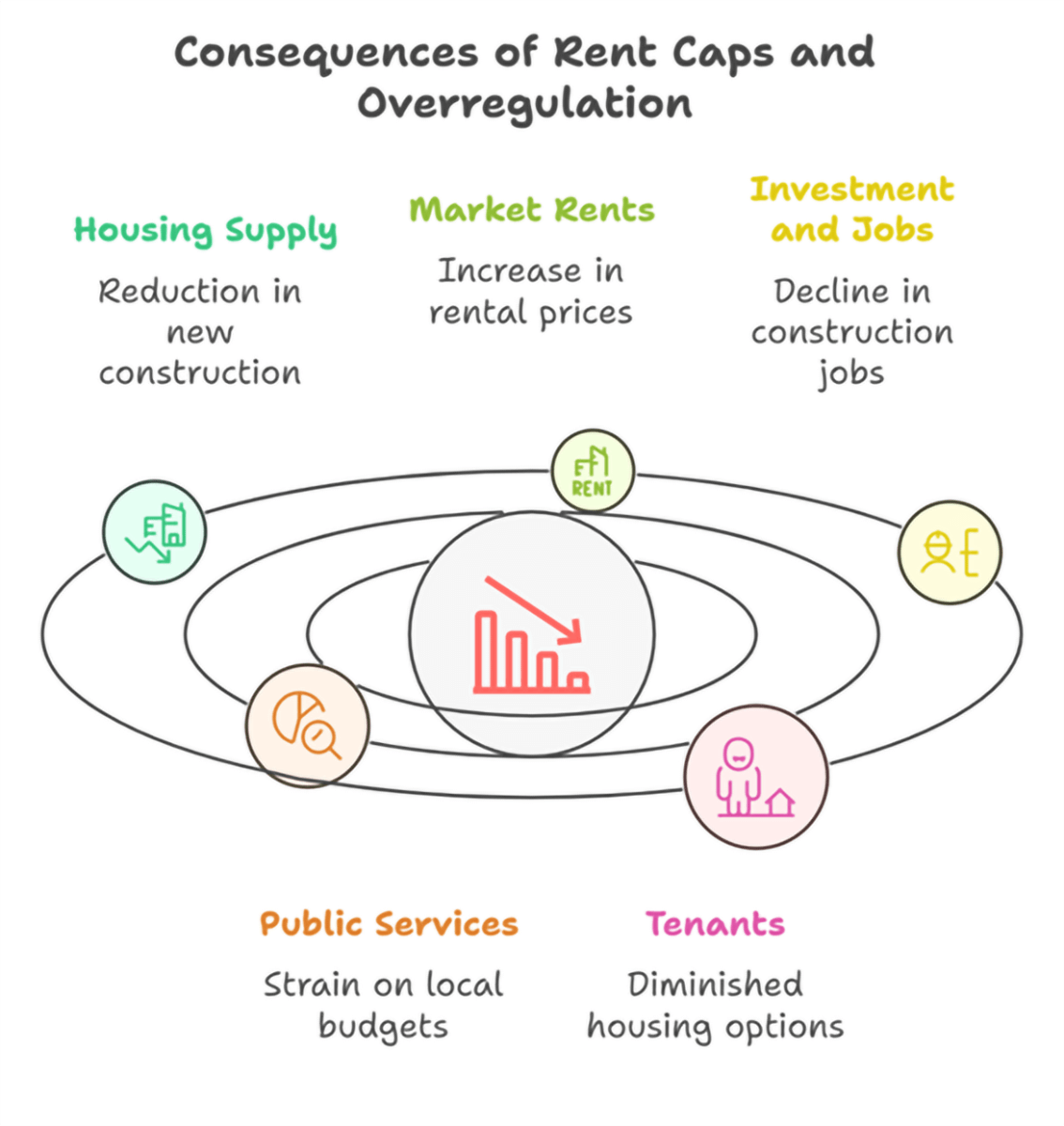
- Deteriorating Affordability: Housing becomes increasingly unaffordable due to suppressed construction.
- Collapsing Investment: Unpredictable regulations deter investment, further suppressing new housing.
- Escalating Homelessness and Crime: Without stable housing options, homelessness and related social issues worsen dramatically.
- Economic Damage: Reduced investment and declining tax revenues undermine public services, harming economic resilience for all residents.
Yet Washington still has an opportunity to avoid Portland’s fate. Unlike Portland, Washington hasn't crossed into irreparable decline—there’s still time to realign strategies with economic fundamentals. Policymakers must immediately shift their focus back to fostering housing supply growth, incentivizing stable investment conditions, and trusting market mechanisms over heavy-handed regulation.
Refocusing on these core economic principles—Washington’s true Center of Gravity—is not merely smart policy; it is essential to avoid the destructive gravitational pull of excessive regulation, which Clausewitz warned inevitably leads to strategic collapse.
Washington's future prosperity depends on policymakers recognizing and nurturing the true CoG—housing supply and private investment. Anything else risks repeating Portland’s devastating cycle of economic deterioration and housing unaffordability.
The window of opportunity to pull back from the brink is closing. Washington must urgently restore market fundamentals to prevent irreversible decline.

Washington stands at a critical crossroads—it hasn't yet crossed into the irreversible collapse of its rental housing market, but the warning signs are clear. Drawing on Clausewitz’s strategic insight into the Center of Gravity (CoG), it's evident that continuing to misidentify the true CoG will lead directly to strategic failure, economic stagnation, and worsening affordability.
Clausewitz explicitly warned: “If we mistake the Center of Gravity for something it is not, all will be lost.”
Washington’s policymakers have mistakenly focused their housing strategy on symptoms—such as rising rents and homelessness—rather than addressing the root causes: insufficient housing supply and constrained private investment. Continuing down this path, relying on short-term solutions like rent control, restrictive tenant regulations, and temporary subsidies, only amplifies the crisis.
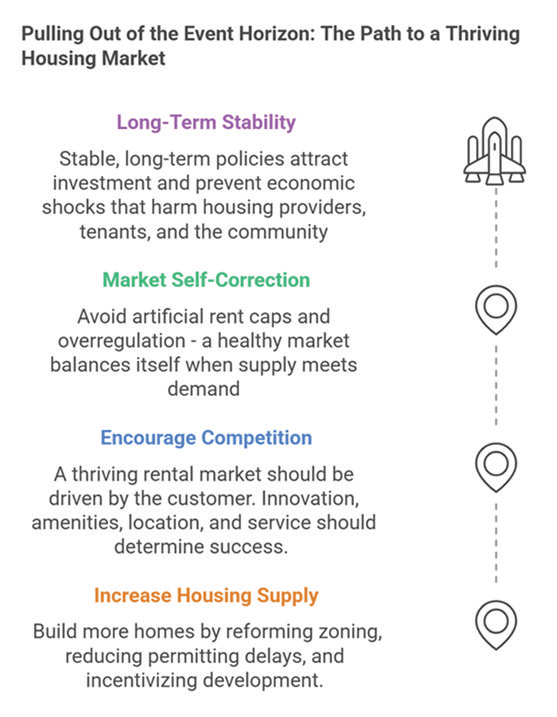
Pulling Out of the Event Horizon: The Path to a Thriving Housing Market Correcting the Trajectory
To prevent sliding into a Portland-like collapse, Washington must:
- Increase Housing Supply: Streamline zoning, accelerate permitting, and remove regulatory barriers.
- Stabilize Investment Conditions: Create predictable, consistent policies to attract sustained housing investment.
- Enhance Market Competition: Encourage a dynamic market driven by innovation and customer-focused housing options, rather than rigid governmental constraints.
A Final Warning and a Path Forward
Historical evidence is unequivocal: rent control and excessive regulation consistently lead to declining investment, collapsed housing construction, and persistent affordability crises. Washington is rapidly approaching a point where recovery becomes impossible. But there’s still time.
The choice Washington faces today is clear:
- Continue on a path already proven to fail. A path that prioritizes short-term regulations and punitive measures against housing providers, worsening housing shortages and economic decline, or;
- Realign strategically around the true Center of Gravity—housing supply, private investment, and market-driven solutions that naturally produce affordability, stability, and growth.
Washington policymakers have an opportunity to act decisively, learn from proven outcomes, and pull back from the brink. Correctly identifying and protecting the housing market’s true CoG—housing supply and private investment—is essential for a prosperous, affordable future.
The clock is ticking—but the opportunity to secure a thriving housing market and economic stability remains.
SOURCES
This article is based on data from state housing reports, economic research, and real estate market analyses on rent control and housing policy.
Housing Market & Economic Data
- Washington Office of Financial Management (OFM), 2023 – Historical home prices, rental rates, and housing trends.
- Redfin, 2025 – Home prices, mortgage rates, and rental market trends.
- Washington Housing Finance Commission (WSHFC), 2024 – Vacancy rates and rental market conditions.
- King County Affordable Housing Dashboard, 2024 – Housing supply needs and construction rates.
Economic & Policy Research
- ECONorthwest, 2019 – Rent control’s economic effects in Washington, including 45% decline in housing starts, $114M annual tax loss, and 10,125 jobs lost.
- Stanford University (Diamond, McQuade & Qian, 2019) – San Francisco study showing 15% rental supply loss under rent control.
- Brookings, 2020 – Research on rent regulation, investment, and housing affordability.
- National Multifamily Housing Council (NMHC), 2023 – Rent control impacts on construction and investment.
- Urban Institute, 2023 – Zoning reforms and their effect on housing development.
Case Studies: Portland, St. Paul, & San Francisco
- Portland Metro Chamber, 2025 – 14,600 construction jobs lost since 2019 due to housing policy.
- St. Paul Planning & Economic Development, 2022 – 80% drop in multifamily permits after rent caps.
- Minnesota Multi-Housing Association, 2023 – $4.5M annual property tax loss due to rent control.
Legislative & Migration Data
- Washington State Legislature, 2025 – HB 1217 & SB 5222 rent control proposals.
- U.S. Census Bureau, 2023 – WA gained 83,619 residents, while OR (-6,896) and CA (-268,052) saw declines.

